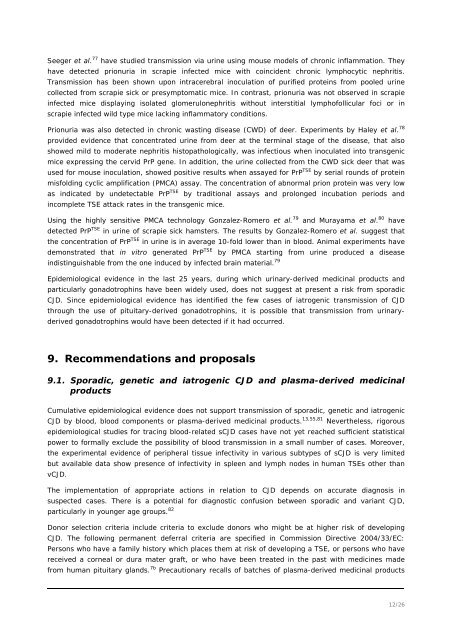CHMP position statement on Creutzfeldt-Jakob disease and plasma ...
CHMP position statement on Creutzfeldt-Jakob disease and plasma ...
CHMP position statement on Creutzfeldt-Jakob disease and plasma ...
Create successful ePaper yourself
Turn your PDF publications into a flip-book with our unique Google optimized e-Paper software.
Seeger et al. 77 have studied transmissi<strong>on</strong> via urine using mouse models of chr<strong>on</strong>ic inflammati<strong>on</strong>. They<br />
have detected pri<strong>on</strong>uria in scrapie infected mice with coincident chr<strong>on</strong>ic lymphocytic nephritis.<br />
Transmissi<strong>on</strong> has been shown up<strong>on</strong> intracerebral inoculati<strong>on</strong> of purified proteins from pooled urine<br />
collected from scrapie sick or presymptomatic mice. In c<strong>on</strong>trast, pri<strong>on</strong>uria was not observed in scrapie<br />
infected mice displaying isolated glomerul<strong>on</strong>ephritis without interstitial lymphofollicular foci or in<br />
scrapie infected wild type mice lacking inflammatory c<strong>on</strong>diti<strong>on</strong>s.<br />
Pri<strong>on</strong>uria was also detected in chr<strong>on</strong>ic wasting <strong>disease</strong> (CWD) of deer. Experiments by Haley et al. 78<br />
provided evidence that c<strong>on</strong>centrated urine from deer at the terminal stage of the <strong>disease</strong>, that also<br />
showed mild to moderate nephritis histopathologically, was infectious when inoculated into transgenic<br />
mice expressing the cervid PrP gene. In additi<strong>on</strong>, the urine collected from the CWD sick deer that was<br />
used for mouse inoculati<strong>on</strong>, showed positive results when assayed for PrP TSE by serial rounds of protein<br />
misfolding cyclic amplificati<strong>on</strong> (PMCA) assay. The c<strong>on</strong>centrati<strong>on</strong> of abnormal pri<strong>on</strong> protein was very low<br />
as indicated by undetectable PrP TSE by traditi<strong>on</strong>al assays <strong>and</strong> prol<strong>on</strong>ged incubati<strong>on</strong> periods <strong>and</strong><br />
incomplete TSE attack rates in the transgenic mice.<br />
Using the highly sensitive PMCA technology G<strong>on</strong>zalez-Romero et al. 79 <strong>and</strong> Murayama et al. 80 have<br />
detected PrP TSE in urine of scrapie sick hamsters. The results by G<strong>on</strong>zalez-Romero et al. suggest that<br />
the c<strong>on</strong>centrati<strong>on</strong> of PrP TSE in urine is in average 10-fold lower than in blood. Animal experiments have<br />
dem<strong>on</strong>strated that in vitro generated PrP TSE by PMCA starting from urine produced a <strong>disease</strong><br />
indistinguishable from the <strong>on</strong>e induced by infected brain material. 79<br />
Epidemiological evidence in the last 25 years, during which urinary-derived medicinal products <strong>and</strong><br />
particularly g<strong>on</strong>adotrophins have been widely used, does not suggest at present a risk from sporadic<br />
CJD. Since epidemiological evidence has identified the few cases of iatrogenic transmissi<strong>on</strong> of CJD<br />
through the use of pituitary-derived g<strong>on</strong>adotrophins, it is possible that transmissi<strong>on</strong> from urinaryderived<br />
g<strong>on</strong>adotrophins would have been detected if it had occurred.<br />
9. Recommendati<strong>on</strong>s <strong>and</strong> proposals<br />
9.1. Sporadic, genetic <strong>and</strong> iatrogenic CJD <strong>and</strong> <strong>plasma</strong>-derived medicinal<br />
products<br />
Cumulative epidemiological evidence does not support transmissi<strong>on</strong> of sporadic, genetic <strong>and</strong> iatrogenic<br />
CJD by blood, blood comp<strong>on</strong>ents or <strong>plasma</strong>-derived medicinal products. 13,55,81 Nevertheless, rigorous<br />
epidemiological studies for tracing blood-related sCJD cases have not yet reached sufficient statistical<br />
power to formally exclude the possibility of blood transmissi<strong>on</strong> in a small number of cases. Moreover,<br />
the experimental evidence of peripheral tissue infectivity in various subtypes of sCJD is very limited<br />
but available data show presence of infectivity in spleen <strong>and</strong> lymph nodes in human TSEs other than<br />
vCJD.<br />
The implementati<strong>on</strong> of appropriate acti<strong>on</strong>s in relati<strong>on</strong> to CJD depends <strong>on</strong> accurate diagnosis in<br />
suspected cases. There is a potential for diagnostic c<strong>on</strong>fusi<strong>on</strong> between sporadic <strong>and</strong> variant CJD,<br />
particularly in younger age groups. 82<br />
D<strong>on</strong>or selecti<strong>on</strong> criteria include criteria to exclude d<strong>on</strong>ors who might be at higher risk of developing<br />
CJD. The following permanent deferral criteria are specified in Commissi<strong>on</strong> Directive 2004/33/EC:<br />
Pers<strong>on</strong>s who have a family history which places them at risk of developing a TSE, or pers<strong>on</strong>s who have<br />
received a corneal or dura mater graft, or who have been treated in the past with medicines made<br />
from human pituitary gl<strong>and</strong>s. 7b Precauti<strong>on</strong>ary recalls of batches of <strong>plasma</strong>-derived medicinal products<br />
12/26


